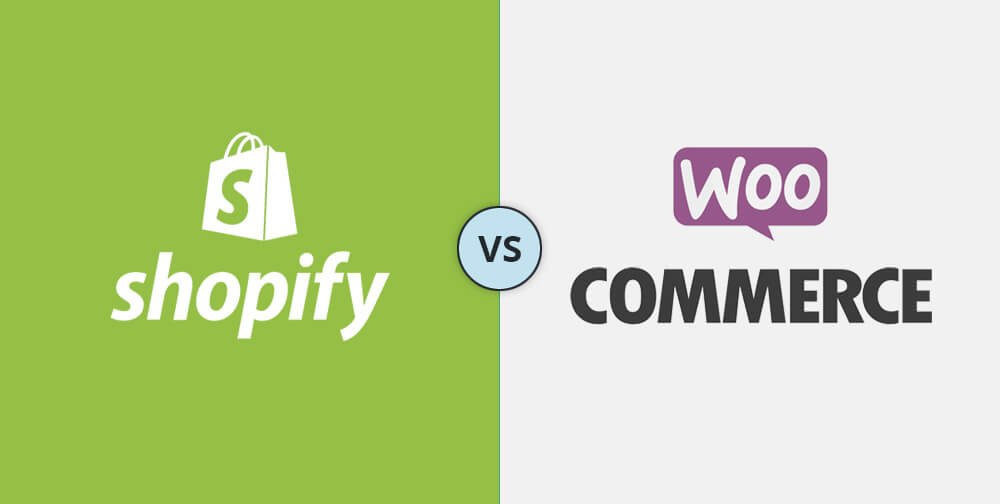In 1979, Michael Aldrich of the United Kingdom connected his telephone line to a modified television linked to a multi-user computer that transacted in real-time. And thus eCommerce was born. Since then, its revolutionised the way we do business online, shattered traditional models and captured the hearts and minds of both business and consumer.
In the wake of this innovation, two eCommerce leaders emerged — WordPress’s WooCommerce and multinational platform Shopify. Let’s unpack these eCommerce trailblazers in our post on WooCommerce vs Shopify.
WooCommerce vs Shopify:
The Definitions
WordPress is many things, so for the purpose of this article we’ll be highlighting its eCommerce offering, WooCommerce. Powering over 28% (as of October 2023) of all internet stores, WooCommerce is the most popular eCommerce platform on the web. While not ‘out of the box’ like Shopify, it’s still the most customisable (see how to customize WooCommerce) platform for building your online business, giving developers the functionality they need and store owners a simple platform to move multiple products.
On the other hand, Shopify is a web application expressly designed for online merchants to set-up and launch their own online store. Similar to WooCommerce, Shopify is geared towards professionals of any experience level, offering an intuitive, customisable framework to personalise stores without having to get into the complexities code. See here too for a Shopify Upsell guide and how to add a Click To Call Widget in Shopify, which can be applied to your WordPress store too.

The Differences
6 main differences when comparing WooCommerce vs Shopify.
1. Content management:
WooCommerce has content versioning, which means that every one of your pages and posts can be safely stored on the system for simple roll-back to previous iterations, at any time. The categories and tags are versatile too, helping you deliver relevant product offerings to accurate demographics.
Shopify’s product and collection management is simple and straightforward. Particularly its ‘automated collections’ feature, which uses rule-based functionality like product title, price, and tag to create and organise shop collections. This can save immense amounts of time, depending on the size of the store.
2. Adaptability:
As it’s the older of the two, WooCommerce has access to a greater wealth of plugins, templates and integrations. Both its open source nature and hosting gives users total control of their websites and makes it simpler to create tailor-made websites.
With that said, however, Shopify does have a wealth (read: thousands) of apps in its app store. The $29 and over plans give you access to your store’s CSS and HTML, which enhances the platform’s versatility and functionality.
3. Mobile device performance
In terms of mobile performance, when comparing WooCommerce vs Shopify, the two are relatively on par with one another. The officially sanctioned Shopify templates are built to be responsive and fast across all devices, and it isn’t difficult to find a WooCommerce template that does the same. Problem is, there are a few legacy WooCommerce templates out there that may not be specifically developed for responsiveness.
Luckily, both platforms integrate with the Google-supported project Accelerated Mobile Pages (AMP). ‘AMP is an open-source HTML framework that provides a straightforward way to create web pages that are fast, smooth-loading and prioritize the user-experience above all else.’ It also significantly speeds up page-loading times on mobile devices by removing certain pieces of code.
4. Templates and themes
The above refers to the layout of your website — consider them the wireframes that exist before your content is added. They also make creating your website far simpler than having to build it from scratch.
In the size department, WooCommerce is the clear winner. And by quite a margin. There are thousands of eCommerce themes to choose from, with the addition of innumerable plugins provided by third-party developers. However, some themes and plugins are better than others, so we’d recommend using one of WordPress’s own eCommerce offerings or themes that have been developed by a reputable, specialist WordPress developer.
At the moment, Shopify has 70+ themes to choose from. 10 are free, and the remaining themes are priced from $140. While it does give one pause, it’s a sound investment when you take the simple customisation and mobile responsiveness into account.
5. eCommerce functionality
WooCommerce just can’t be beaten when it comes to the sheer number of searchable tools and features. Here are just a few:
- A blogging feature is included out-of-the-box.
- Online stores can sell unlimited physical or digital products.
- Product filtering and sorting, and reviews and ratings come integrated.
- Robust abandoned cart functionality.
However, certain plugins have to be installed to make the experience more comprehensive. But once they’re in, you get features like:
- Calculators for shipping.
- Multilingual translation.
- Guest checkouts.
Shopify has hundreds of features and comes with shipping, inventory and analytical tools built-in, with the option of expanding the toolset with enhanced versions, at additional costs. Some of its top functionalities include:
- Omnichannel integration, allowing merchants to sell their wares across different digital channels.
- Discount codes to delight users at checkout.
- Email reminders automatically fired off to users who abandon their carts.
6. Pricing
There’s a big difference in set-up and pricing between the two eCommerce platforms. To implement WooCommerce, WordPress recommends:
“WooCommerce is a plugin, so you’ll need a WordPress site that can use plugins. The very first thing you’ll need to do is choose is a host for your store and buy a plan.
This is actually quite easy. WooCommerce and WordPress both recommend hosts like SiteGround, BlueHost, and Pressable. These hosts are great to start with, although if you’re migrating an eCommerce store, or will be running a large site, work with a host with specific WooCommerce expertise. WordPress.com also offers a Business plan, which allows sites to upload plugins.”
Once that’s done, you can choose an eCommerce theme for your store that aligns with your goals and the scope of product you intend to purvey.
Shopify, on the other hand, is a website builder specifically developed for eCommerce. The platform has three tiers:

So which offers more bang for your buck? In terms of support, customisation and overall performance, we believe that WooCommerce just pips Shopify here.
General pros and cons
Before we sign off, we’d be remiss not to provide a few of the broader pros and cons pertaining to each platform. First off, the positives on WooCommerce vs Shopify:
WooCommerce pros:
- Unrestricted customisation makes it the more powerful and flexible of the two.
- Gutenberg — WooCommerce’s latest editing tool — makes the platform simpler to use.
- A supportive community and a comprehensive library of resources help make managing your online shop a breeze.
WooCommerce cons:
- A certain level of tech experience is needed, and hosting, security and domain will need to be set-up before you’re able to launch your store.
Shopify pros:
- No coding or tech experience is required to set up the platform.
- Its out-of-the-box nature means you don’t have to fork out cash for domain hosting or security.
Shopify cons:
- Shopify charges extra transaction fees (0.5% – 2% per each one) if you don’t make use of its payment gateway.
- The platform is inflexible at times: if you want to change your theme, you’ll have to overhaul your existing content.
The verdict on WooCommerce vs Shopify
WooCommerce sits atop one of the most robust frameworks on the internet. The platform’s solid reputation has been built on a free, simple and intuitive framework that almost anyone can use. Throw in the fact that WordPress powers 34% of the internet, and you’ve got a foundation that can’t be beaten. With WooCommerce, you get an online community like no other and a seemingly endless wealth of resources to mine.
Although Shopify is simple to set-up and use, it just doesn’t quite have the depth of its rival. For us at Kaira, WooCommerce is the clear winner in our comparison of WooCommerce vs Shopify.

In eCommerce, a helping hand goes a long way
Since 2014, Kaira has developed best-in-class WordPress themes and plugins that empower users to easily set-up their online stores. Our themes are listed on WordPress.org at the most competitive prices in the industry.
What’s more, we’ve just released our brand new WooCommerce plugin, which makes setting up and managing your online store super easy. Did we mention we also provide ongoing support? Click here for Kaira’s StoreCustomizer.



